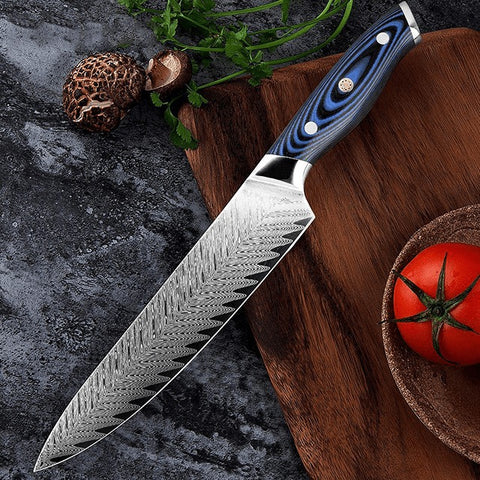The Ultimate Guide to Damascus Steel Chef Knives
A top-tier chef knows that a well-crafted Damascus knife is an essential part of any kitchen arsenal. Known for its exceptional quality and timeless beauty, a Damascus knife is more than just a tool—it’s a masterpiece combining ancient craftsmanship with modern innovation. This article will explore what makes these knives extraordinary, how to select the perfect one, and tips for maintaining their pristine condition.

### What Exactly Is Damascus Steel?
Damascus steel has captured the hearts of many thanks to its mesmerizing wavy patterns and unmatched toughness. Originating in the Middle East, blacksmiths crafted these blades by repeatedly folding and hammering layers of steel and iron. This technique created a blade that was both exceptionally hard and remarkably flexible, ensuring that it stayed sharp for extended periods while resisting breakage—a testament to the ingenuity of ancient artisans.
Today, Damascus steel retains its allure not only because of its practicality but also due to its visual splendor. Contemporary versions mimic the intricate patterns and superior qualities of their historical counterparts, making them both functional tools and stunning works of art. The swirling designs aren’t just aesthetically pleasing—they also symbolize durability and reliability.
### The Rich History of Damascus Steel
The story of Damascus steel dates back to around 300 BC when skilled craftsmen discovered that by repeatedly heating and folding layers of steel and iron, they could produce weapons that were far stronger and more resilient than anything else available at the time. These early efforts led to the creation of swords and blades that became legendary for their strength and endurance.
Over centuries, the art of crafting Damascus steel evolved, blending traditional methods with modern advancements. Today’s knife makers replicate the timeless elegance and superior performance of historical pieces, ensuring that Damascus steel remains relevant in today’s kitchens.
### Key Features of Damascus Steel Chef Knives
Several characteristics set Damascus steel apart, making it a prime choice for professional chefs:
- **Durability:** The repeated folding process results in a blade that is highly resistant to chipping and breaking, ensuring long-lasting performance.
- **Sharpness:** Unlike other steel blades, Damascus steel retains its edge for significantly longer periods, reducing the frequency of sharpening.
- **Aesthetics:** Each blade boasts a unique wavy pattern, making every knife a one-of-a-kind piece of art.
### Types of Damascus Steel Chef Knives
Depending on your specific culinary needs, various Damascus steel knives cater to different tasks:
- **Kiritsuke Japanese Knife:** Ideal for precision cuts, especially when handling vegetables. Its design allows for clean, thin slices, making it indispensable in professional kitchens.
- **Gyuto Japanese Knife:** Versatile and adaptable, the Gyuto knife can tackle almost any cutting task except for bone. It’s an excellent all-around choice for everyday cooking.
For example, the **Kiritsuke Japanese Knife Damascus Steel with Colored Ebony Handle** excels in creating precise cuts, while the **Gyuto Japanese Damascus Steel Knife with Colored Blue Handle** serves as a reliable all-purpose slicer, fitting seamlessly into any kitchen setup.
### Blade Length and Handle Design
When selecting a Damascus steel chef knife, consider both the blade length and handle design:
- **Blade Length:** Ranging from six to twelve inches, choose a length that feels comfortable in your hand and aligns with your cutting needs.
- **Handle Design:** Opt for handles that provide a secure grip and reduce strain during prolonged use, such as the **Kiritsuke Japanese Damascus Steel Chef Knife with Colored Octagonal Handle**, which offers both comfort and control.
### Maintaining Your Damascus Steel Chef Knife
Proper care ensures your knife remains in peak condition for years to come. Here’s how to keep it in tip-top shape:
- **Cleaning and Storage:** Always hand wash your knife with mild soap and warm water, then dry thoroughly. Dishwashers can damage both the blade and handle.
- **Storage:** Store your knife in a knife block or on a magnetic strip to avoid contact with other utensils, preventing accidental dulling.
- **Sharpening/Honing:** Regular honing with a honing rod helps maintain the blade’s sharpness over time.
### FAQs
- **How Often Should I Sharpen My Damascus Steel Chef’s Knife?**
For casual cooks, sharpening every few months suffices. Professional chefs may need to sharpen theirs more frequently to maintain optimal performance.
- **Can I Put My Damascus Steel Knife in the Dishwasher?**
No, hand washing is mandatory to preserve the integrity of both the blade and handle.
- **Is Investing in a Damascus Steel Knife Worth It?**
Absolutely! These knives offer unparalleled durability, sharpness, and aesthetic appeal, making them a wise investment for serious cooks.
- **Can I Use My Damascus Steel Knife for All Kinds of Food?**
While versatile, it’s best to use these knives for tasks they’re designed for—like slicing and chopping—to maintain their edge and lifespan.
### Conclusion
A Damascus steel chef’s knife is more than just a kitchen tool; it’s a blend of artistry and functionality. With its remarkable strength and exquisite design, it promises excellent service in any kitchen. By choosing the right blade and caring for it diligently, you’ll enjoy the benefits of owning such a knife throughout your culinary journey.
Squid Tempura,Fried Calamari Tempura,Tempura Calamari Rings,Tempura Fried Calamari
Zhejiang Industrial Group Co., Ltd. , https://www.xingyeseafood.com